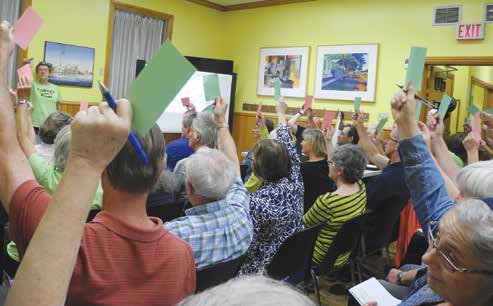Every issue of The Mainstreeter has a report of some new development project, proposal or issue and how residents and their organizations have responded to it. In this two-part ‘report card’ series, John Dance provides his perspective on the public consultation that happened (or didn’t) in relation to the many major initiatives that Old Ottawa East has seen over the last couple of decades.
John Dance
As a general rule, it appears that where there has been substantial public consultation, an initiative’s outcome has, from the standpoint of most Old Ottawa East (OOE) residents and the OOE community association (OOECA), been much better than where consultation has been limited or after the fact or where responses have been ignored.
While perhaps this should be obvious, somehow and sometimes governments and their agencies and private developers elect to proceed with limited public consultation and little willingness to change direction.
In the following discussion on major initiatives, the “Gunning Principles” are used to assess the quality of public consultation. These principles, as publicized by the UK’s Local Government Association, were coined by lawyer Stephen Sedley in a court case relating to a school closure consultation. In that case, Sedley argued that public consultation is only legitimate when:
1. Proposals are still at a formative stage (that is when the decision has not already been taken and the so-called public consultation is simply an opportunity for the proponent to say they shared information and sought input);
2. There is sufficient information to give “intelligent consideration.” The information provided must relate to the consultation and must be available, accessible, and easily interpretable for consultees to provide an informed response;
3. There is adequate time for those consulted to consider and respond; and
4. “Conscientious consideration” must be given to the consultation responses before a decision is made.
In addition to these principles, successful community consultation depends on a variety of other factors including the capacity of those consulted to assess and respond; the context for the consultation; and the inclusiveness of who is able to participate. So, how have the most recent OOE public consultation exercises rated? In the next two issues of The Mainstreeter, beginning with the most recent Lansdowne Park development initiative, we’ll provide readers with our consultation report card.
1. Lansdowne Park
As described in April’s issue of The Mainstreeter, some consultation on the Lansdowne 2.0 initiative is now underway, but the proposals are most definitely not at a “formative stage.” Last year, City Council approved in principle what would be done to make Lansdowne Park “sustainable,” given that the financial performance of the 2012-2014 renovations have not achieved the forecast financial results.
Citizens were not asked in advance about the desirability of demolishing the northside stands and the arena and then building new stands and a new “entertainment centre” on what is now mostly green space. Nor were they consulted on the plan to pay for at least $332 million of construction by diverting tax dollars, selling off air rights for three high-rise towers, and, optimistically, predicting that 60,000 square feet of new commercial space will generate significant profits.
Has “sufficient information” been provided? Clearly there has been inadequate financial information. For example, there has been no explanation of who will pay for the municipal services required by the 2,500 new tower residents, given that 90% of their taxes are being diverted to pay for the stadium/event centre rather than for needed incremental services. There have been no options presented whereby residents could weigh in on whether, for instance, the LRT-less Lansdowne is the best location for a new entertainment centre.
And there certainly has not been adequate time for the public to respond. The City of Ottawa is rushing through a zoning bylaw amendment to allow construction of the three towers and has already sought “expressions of interest” for the purchase of the tower air rights.
It’s unlikely that there will be any “conscientious consideration” of residents’ perspectives when it appears as though the City is already well on its way to realizing the OSEG-City vision.
It’s a repetition of the consultation pattern of the earlier Lansdowne project completed in 2014 that promised “a new, vibrant and transformed Lansdowne as a world-class venue that would [amongst other things] revitalize the existing stadium and arena for sports and entertainment events.” Now, the City and OSEG want to demolish the “revitalised” stadium and arena and waste the tens of millions that was spent on the renovations.
One positive note: the “public realm/urban park” portion of Lansdowne 1.0 reflected community input and it has been a notable success. Now, however, Lansdowne 2.0 proposes to reduce the size of the public realm because parkland is needed for the new entertainment centre.
The advocates of both phases of Lansdowne refurbishment have argued that the changes are/will be much better than what previously existed because the large surface parking lots have been eliminated. The reality is that the parking lots have been replaced by new commercial buildings that have fundamentally changed the nature of the park.
Public Consultation grade for both Lansdowne 1.0 and 2.0: Grade F
2. Highway 417 Downtown Bridge Replacement Project
The proposal to detour Canal parkway traffic for almost two years as the Highway 417 Canal bridge is replaced is most definitely not at a “formative stage.“ Engineers of the Ministry of Transportation of Ontario (MTO) have been working on the plan for more than five years and there have been only three opportunities for residents to comment. That said, MTO has consulted with other governments and their agencies (like the City of Ottawa, Parks Canada and the NCC) and these parties concurred with the MTO proposal. However, they did so without any consultation with those who will be affected, and without demanding traffic studies to assess the impacts of the detours.
MTO says the two-year detour plan is in response to consultation done three years ago when a variety of parties opposed the initial idea of demolishing two buildings to facilitate the bridge replacement. But the community opposition back then was made without knowledge that the MTO alternative to the demolition plan would be to have two-year detours. So, no, there certainly has not been “sufficient information” for residents to give “intelligent consideration.”
And there hasn’t been adequate time for residents to consider and reply. Indeed, many people, including Glebe residents, only recently became aware of MTO’s plans to detour parkway traffic. As for MTO’s “conscientious consideration” of residents’ concerns, there appears to be little of this as the Ministry argues that through the November “public information centre,” there were only 12 people who raised concerns about the detours.
Public Consultation Grade F
3. Flora Footbridge
The consultation process for the Flora Footbridge was long and varied. There was even a separate consultation process for selecting the name for the bridge. The idea for the project itself was long shared by many residents so that consultation wasn’t a matter of pushing back against something being done to a community but rather working to make an idea as good as possible for as many as possible.
Key aspects of the consultation were an environmental assessment that sought residents’ views and three open houses that invited residents’ comments. Also, the City’s project manager, Colin Simpson, was very open to discussing the proposal with residents.
Initially deemed by a Glebe resident “a bridge to nowhere,” the proposal gained traction and with the critical support of then-new Ottawa Centre MP Catherine McKenna and then-MPP Yasir Naqvi most of the necessary funding was provided by the federal and provincial governments, so the proposal did not encounter delays on the financial front. Also, Councillor David Chernushenko was a steadfast proponent of the bridge. The three community associations of OOE, OOS and the Glebe were all strong supporters of the project so that gave impetus for moving forward.
Several design issues were not resolved to the satisfaction of a number of parties, most notably how the east-side abutment and ramp blocks the Canal views of Echo Drive residents and also the hairpin turn on the east ramp. And the initial graceful, curved shape with a wider deck at the middle was scrapped when the City did a “value-engineering” review of the project in an effort to reduce costs.
All principles for good consultation were respected.
Public Consultation Grade A
In the next issue of The Mainstreeter, John Dance grades other OOE mega-projects on adherence to “legitimate” public consultation principles, including the Greenfield/Main/Hawthorne reconstruction and the Greystone Village 2B development







